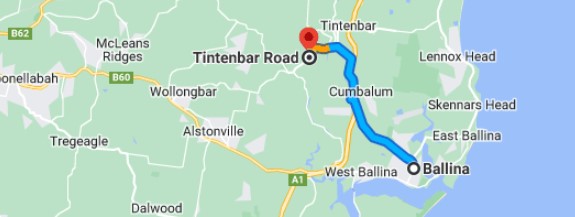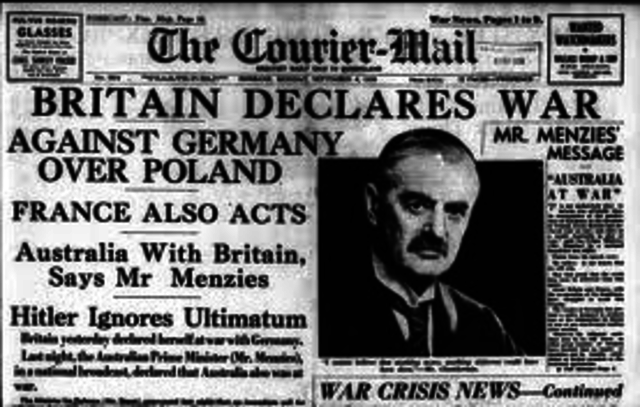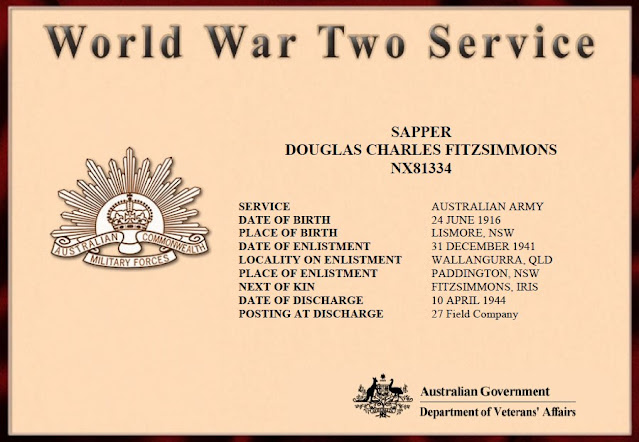This post will be an attempt to tell some of the story of Iris Belle Barrow (1921 - 1966), my paternal 3rd cousin once removed.
Our Common Ancestors are: James Exton and Susannah Lancaster.
I never met Iris or any of her family, and have only come to know about her through the limited information shared by extended relatives on Ancestry.com and the research I've done about the events of the relevant time span. I admit this story may be a little sketchy and not fully correct, so if any better informed relatives do read through this and can offer clarification, please do so.
I've been intrigued with Iris ever since I first saw this photo shared on Ancestry.
 |
| Photo originally shared by cbroughton195 (my 4th cousin) on Ancestry.com |
My family tree is full of very resilient women who lived quite tough lives and certainly never lived a life of luxury or experienced what I would call, a prosperous life.
This photo of Iris could give the impression that she was the exception though ... given the luxurious fur coat she is wearing and that stunning hat!
That was the very first thing that drew my attention in this photo ... that magnificent looking hat. I thought all those black spots were imperfections on the photo, but then I realised the hat comes complete with a net / veil that comes down over the front of her face. Perhaps this was a fashion trend in Australia at the time, which would have been the late 1930s.
The beautiful flowers atop her curls are such a stylish addition as well. That is not an everyday hat! Not many of my extended relatives ever got to wear a fur coat either. This young woman emanates poise, elegance and style. I wondered where she was going on this day, dressed so fashionably. What grand event was she attending?
When I discovered her name was 'Iris', it seemed a perfect match somehow.
Iris is a girl's name of Greek origin, meaning "colourful" or "rainbow". Iris was the name of the Greek goddess of the rainbow, and she served as a messenger to the gods.
As I looked more deeply into the details of Iris's life however, it soon became apparent that she did not live a life of luxury and extravagance at all!
Her eldest brother was Harold Allan Barrow, born in 1910. Her second eldest brother was John Alfred (known as Jack) Barrow, born in 1913. Her other older brother was Charles Neville Barrow, born in 1915 (although he was known as Neville Charles throughout his lifetime).
I wonder what Iris's childhood would have been like, growing up with three older brothers? There was an 11 year age gap between Iris and her oldest brother Harold. The middle brother John (known as Jack) was 8 years older, and the youngest of the brothers was 6 years older than Iris. Did they treat her as a princess or as a tomboy?
I have limited information about life for Iris between her birth and her tenth birthday, but jumping ahead a little I know her teenage years coincided with the Great Depression, a time when many experienced enormous hardships and challenges.
Here in Australia, there was a surge in unemployment rates at the start of the 1930s and many people's lives changed drastically as a result. I know that Iris's father, Alfred Barrow, worked as an employee of the Railway Department throughout the depression years, so that must have been a saving grace for the family. given that in 1932 the official unemployment level reached a peak of 32%.
Census records for the period between 1929 and 1940 show where Iris's father Alfred and mother Mary Ellen were living. As Iris was only 8 years old in 1929 and turned 18 in 1940, she would have been living with her parents during these years. The census records show that Iris's parents moved around a bit during this time, and I would suspect that was because of her father's job.
In 1930, when Iris would have turned 9, the family was living at 10 Peate Street in Lismore. Iris's father Alfred's occupation was listed as 'fettler'. Iris's uncle, her father Alfred's brother, William and his wife were living in the same street.
A 'fettler' was an employee of the Railways whose job it was to maintain a section of a railway line. They had to walk, or ride a trolley, along a 10-15 mile long section of the railway line every day to inspect it for any possible problems that needed repair work. It was hard physically exhausting work.
Fettlers would have to replace decaying sleepers and worn rails, check all the bolts on fishplates and tighten these whenever needed, as well as clear the line of fallen trees, and in the flood-prone Lismore area, they would have to clear flood debris and repair damaged sections of the line after major flooding events. Iris would have witnessed first-hand the toll that such physical work must have taken on her father.
Fettlers worked in small gangs under the supervision of a ganger, and most usually lived in railway tents in camps next to the line. As Iris's family was living in town, that meant either her father was working a section of track close to the town itself or he would spend weeks at a time away from home living and working with his fettler gang. Either way, I think that Iris probably spent more time with her mother and brothers, than she did with her father while she was growing up.
By 1932, the family had re-located to Ballina, situated in the Northern Rives Region about 34 kms (21 miles) from Lismore, and closer to the coast.
Iris was now 11 years old and the family was living at 356 River Street in Ballina, which would have been on the outskirts of the town at the time and quite close to the mouth of the Richmond River. Iris's brother Harold Allen Barrow had married Florence Robertson in 1931 and they were living in Ballina East. I'm assuming that Iris's other brothers, John aged 19 and Neville aged 17, were living with their parents as well.
By 1934, Iris aged 13, was living at 1 Fox Street with her parents and (again, I'm assuming) her brothers John and Neville. Fox Street was closer to the centre of the town. Iris's oldest brother Harold and his wife Florence were still living in Ballina East and had a little daughter.
By the following year, 1935, Iris and her parents had moved once again. They were living at 32 Tintenbar Road, about 12 km (6 miles) to the north-west of Ballina. It's likely the move was a requirement of her father's job at that time.
Iris's brother John Alfred Barrow remained living at 1 Fox Street (presumably with brother Neville) in Ballina, and olderst brother Harold Allen and his wife Florence May were still living in Ballina East, and were expecting another child.
In 1937, Iris, now aged 16, and her parents were back living back in Ballina, at 1 Fox Street with John Alfred and Neville Charles.
 |
| Photo originally shared by cbroughton195 (my 4th cousin) on Ancestry.com |
Soon Iris was of an age when she could start attending dances and balls.
Apparently her brother John loved ballroom dancing and his favourite partner was his sister Iris. They were reportedly both very fine ballroom dancers.
This photo, likely taken sometime between 1939 and 1940, shows Iris and her brother John Alfred attending such an occasion.
Of course, by this time there were events happening overseas that would change the course of world history, and the lives of the Barrow family.
One of the most often mentioned causes of World War 11 was the rise of dictatorial governments with extreme political views and military ambitions during the Great Depression, in the countries of Germany, Italy, Spain and Japan. The Depression had also distracted the democratic powers of Britain, France and the United States as they paid more attention to affairs at home and not international developments.
When the Germans invaded Poland in September of 1939, driving Great Britain and France to declare war on Germany, Iris was just 3 months away from celebrating her 18th birthday.
Iris would have read about what was happening in Europe and read the Australian Prime Minister, Robert Gordon Menzies's statement made on September 3rd, 1939:
"Fellow Australians, it is my melancholy duty to inform you officially, that in consequence of a persistence by Germany in her invasion of Poland, Great Britain has declared war upon her and that, as a result, Australia is also at war."
 |
| Alfred Barrow (far left), John Alfred Barrow (middle) and Douglas Charles Fitzsimmons (right) c. 1940 Photo originally shared by cbroughton195 (my 4th cousin) on Ancestry.com |
In March of 1940 Iris, aged 18, married Douglas Charles Fitzsimmons, aged 23, in Ballina, New South Wales. Of course at that time many young couples found the urge to get married just too compelling to resist, given that so many young men were preparing to march off to war.
The photo above shows Iris's husband Douglas Charles Fitzsimmons on the right, with her father Alfred Barrow (left) and her brother John Alfred (sitting).
The following year, 1941, saw the start of the impact of the Second World War on the Barrow family.
Iris's oldest brother, Harold Allan Barrow, enlisted in March of 1941. He served as a Private in the Australian Army.
Iris's second eldest brother, John Alfred Barrow, enlisted in September of 1941. He also served as a Private in the Australian Army.
Iris's husband Douglas enlisted in December of 1941. He served as a Sapper in the Australian Army.
Interestingly, when Douglas was enlisting he listed 'Wallangurra, Queensland' as being his residential address at that time. Wallangurra is quite a considerable distance inland from Ballina, where Iris's family lived and where she and her husband had married. It's north-west of Tenterfield, and just over the border in southern Queensland. I'm assuming Douglas was away working. I wonder, what type of work was he doing that took him away from his new wife?
Australian women, at the start of the war, were encouraged to take the same sorts of roles they had held during the first world war - knit, sew, pack parcels, encourage enlistment and maintain the home. As war came closer to Australia though, this all changed.
From late 1940, women were encouraged to join the services. Whilst some served as nurses in one of the branches of the armed forces, the majority joined the auxiliary services such as the Women's Auxiliary Australian Air Force (WAAAF), the Australian Women's Army Service (AWAS) and the Women's Royal Australian Naval Service (WRANS).
Iris Belle enlisted with the WAAAF as an Aircraftwoman. She enlisted in late 1942.
This is the enlistment photo taken of Iris in 1942.
 |
| Photo originally shared by cbroughton195 (my 4th cousin) on Ancestry.com |
This is not a photo of Iris.
Beryl enlisted as an Aircraftwoman in the WAAAF the year after Iris did.
There's likely to be a similar photo of Iris in uniform, very much like her sister-in-law.
Initially, women in the forces served as cooks, clerks and kitchen orderlies, but that quickly changed. They were manning anti-aircraft and coastal artillery gun sites, working in ordinance, cipher, electrical, mechanical and intelligence units. They maintained and armed aircraft, operated radars, drove trucks and instructed in drill ... but they did not fly.
Aircraftwomen: top row left - checking aircraft engine components, top row right - working on an aircraft engine, bottom row left - checking the instruments in a bomber cockpit, bottom row - right - loading practice rockets onto a Beaufighter ... some of their varied tasks.Women also became a crucial part of the RAAF communications system and staffed Radio Direction Finding Stations to guide aircraft home. Large numbers of serving women were radio-telephone operators, and the majority of the telephone and teleprinter operators were WAAAF. The coastline was screened by radar, and operators were often on duty 24 hours per day.
According to Iris's service record her first duties were as a "messwoman", but by early 1943 her role was listed as "telephone operator". She served in that role for the remainder of the war. and had various postings - from Bundaberg to Evans Head.
Iris's posting upon discharge was listed as "6 Aircraft Depot". The location of the RAAF's No. 6 Aircraft Depot was at the Army Aviation Airfield at Oakey, on the Darling Downs in Queensland.
The No. 6 Aircraft Depot's primary function was to relieve, repair and carry out overhaul work passed on from No. 3 Aircraft Depot at Amberley Airfield. No. 6 Aircraft Depot was also a forward depot for aircraft operating from New Guinea and northern Australia. The Depot serviced, assembled and conducted test flights of Beaufort, Mustang Norsemen, Wirraway and Spitfire aircraft and also serviced large quantities of communications equipment and radio compass receivers. The site was 934 acres in size, comprising a 400 feet landing strip and 2 hard surfaced runways. The population of personnel was around 2000. Iris must have had an interesting service life. I wonder if she was living on site?
 |
| Photo originally shared by cbroughton195 (my 4th cousin) on Ancestry.com |
By this time Iris had become a mother, having given birth to her son Douglas Terry back in mid 1941 before she enlisted. How did Iris juggle her service and different postings as well as motherhood until her discharge in 1945?
Thankfully Iris's brothers and husband all survived the war years.
Brother John Alfred had been discharged as medically unfit in November of 1941, a couple of months after his enlistment. He had been diagnosed with "fibrositis", now known as fibromyalgia, a disorder of musculoskeletal pain and aching.
Brother Harold Allan was discharged in November of 1943.
Husband Douglas was discharged in April of 1944 after service overseas.
Just a few months after welcoming her husband home from war service, Iris had to say goodbye to her father, Alfred Barrow, who died in November of 1944.
Then tragically, Iris's husband died not long after, in March of 1945, at the age of 28. His death notice, seen above, mentions that he had been ill for quite some time and was living in Queensland at the time of his death. This makes sense as Iris was still serving with the RAAF, and as I have mentioned would have been living in Queensland. She was not discharged until May of 1945, and was discharged on compassionate grounds.
Iris, widowed at the age of 23, after having been married for just five years, was now a single Mum with a child about 5 years old; and it seems she moved back to Ballina after her discharge. There she re-married the following year, in October of 1946. Her second husband was a man named Mervyn Arthur Anthony (Tony) Alvos. They were married for nearly 50 years.
 |
| Photo originally shared by cbroughton195 (my 4th cousin) on Ancestry.com |
This photo would have been taken around the time of Iris's second marriage. She is with her sister-in-law Beryl Barrow nee Wilson. Sitting on the ground are Beryl's daughter Colleen Joan, and Iris's son Douglas Terry. Iris stands out once again in this photo, with her pretty flower-bedecked top and embellished dark skirt. She would have been about 25 years of age.
Iris was to spend the early part of her second marriage, through the late 1940s and 1950s, still living in Ballina, New South Wales.
Sadly, Iris's mother Mary Ellen passed away in 1962.
It was around this time that Iris and her husband Mervyn moved to Queensland. Iris's son, who was now Douglas Terry Alvos, remained living in Cronulla for a time but by 1968, according to the census, they were all living in Acacia Ridge in Queensland.
Iris's life through the 1970s, 80s and 90s was spent living in that same area - Acacia Ridge.
Both of Iris's brothers, Harold and Neville, passed away in 1971.
Iris's brother John Alfred passed in 1988.
Iris herself passed away in January of 1996, aged 74, having outlived her parents and all her brothers.
Special Note to any family members: If you have memories to add, photos or information to share, can I graciously ask that you do so. Please use the comments box below or email me. It may prove to be invaluable to the story and provide future generations with something to truly treasure.























That was fascinating! You've build a good biography based on your limited information. Thanks for sharing!
ReplyDeleteYou've created a nice tribute to your 3rd cousin, and it's thanks to the intriguing photo of her in the flowered hat with veil. She looks a bit forlorn, I wonder if the photo was taken around the time of her 1st husbands death. Thanks for sharing.
ReplyDelete